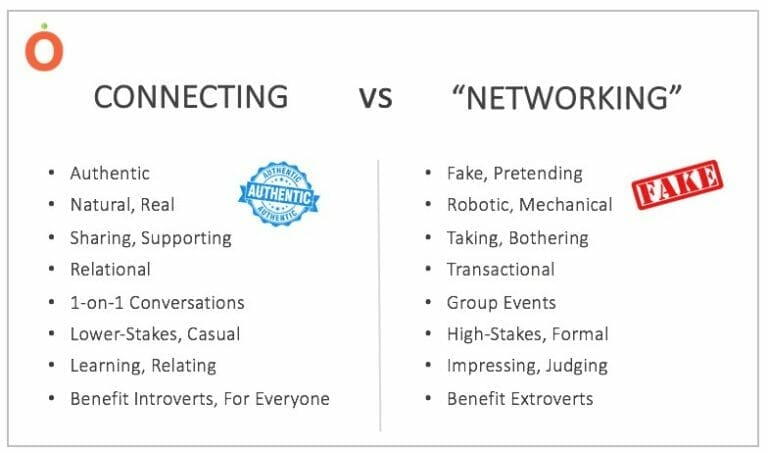
I don’t like bran muffins.
Bran muffins used to be a nutritious choice—something we needed to choke down if we wanted to be healthy. Something we needed to learn to like because it was good for us.
Now we know that isn’t true. There are many more palatable alternatives to chewing cardboard. I’m relieved.
That’s how it is with traditional networking.
Those networking practices you were taught aren’t as good for you or your career as we once thought. There are alternatives today that feel better and work better. It’s a new day for a new way of networking that works for everyone.
What exactly is this this new way of networking? Read on.
The impact of networking today
You are going to change jobs. That’s a given.
Research shows that if you are a millennial, you will change jobs faster than you upgrade your cell phone. Your first-job tenure is likely numbered in months, not years, and you’ll have up to four job changes in the first ten years after graduation.
The primary reason to change is “fit.” But advancement plays a big role too. People who change jobs every two years make 50% more money after ten years than those who don’t move.
Changing jobs is inevitable if you want to advance your career, whether it’s within or across organizations.
So what’s the secret to finding your next job?
The fastest route to a job you love is found through people—not some online job posting. It’s well known that upward of 85% of jobs aren’t even listed online. The key to tapping that large unadvertised job market and finding your dream job is through networking.
But not old-style networking, or even online networking.
The problems with traditional networking
Networking.
Just the idea of it makes us all queasy.
It conjures up images of crowded rooms, fake smiles and rehearsed elevator pitches. The truth is that old-style networking is hard, and it just isn’t effective.

From our research, we found that the reason traditional networking doesn’t work for most of us today. Why?
- It feels fake. Unless you are a self-promoting extrovert by nature, you feel phony. This is the world of “grip-and-grin,” where how you present yourself seems to be more important than who you really are. For most of us—especially us introverts—this is a show-stopper. Pretending to be someone you’re not is not the basis for a real relationship.
- It feels robotic. Tools, like email templates, can make networking easier—but they also make it feel less human. Who doesn’t recognize a canned email or generic LinkedIn request immediately? We all do. Networking resources emphasize the process and completely forget about genuine connection.
- It feels intimidating. It’s natural to be nervous about reaching out to people you don’t know yet. Old-style networking makes it worse. Conventional wisdom recommends you connect with the most senior people in an organization. Not only is that intimidating, but it’s also not very helpful. Today, the best information comes from people you can relate to, at the same level as you or just a rung above.
- It feels like you are bothering people. This is a big one. Old-style networking tends to label people as givers and takers. Most old-style networking resources harp on how busy people are and how much time you are taking. When the networking experience focuses only on efficiency, you feel rushed. And you feel like a nuisance to others. In truth, people want to share their advice with someone who really values it. As humans, we want to make a difference in someone’s life. Speed isn’t a valid measure of success.
Even if you have mustered up the courage to contact someone new, it’s hard to overcome the fear of “doing it wrong.” You’re not sure of what to say, how to say it, what to ask, or how to follow up the right way.
The advice from job search books, web resources and career articles doesn’t help much either. Most is completely outdated. It’s hard to know where to find reliable advice that works in today’s job market.
One thing is certain: The networking practices that worked for other generations simply don’t fit today.
There’s a better way to network—start connecting
We’ve set a pretty low bar for networking. When asked, many people will define a successful networking conversation as one where they didn’t embarrass themselves. We think that’s pretty sad.
It isn’t success—it’s a waste of time on both sides of the table.
Connecting is different way of networking.
What is connecting? Talking one-on-one with people in your own network in a way that taps their specific knowledge. No need to impress anyone. Your focus is on learning about information and opportunities that you won’t find online, and your contact feels valued sharing their advice with someone who needs it. That’s why your contact is here. To make a difference, not just to socialize.
The goal of every connecting conversation is to move your career ahead.

Unlike traditional networking, connecting feels more personal, authentic, and relational—because it is. You have meaningful one-on-one conversations with people and learn from their experiences.
These conversations offer you valuable information that helps shape your career decisions, and may likely get you a referral to the perfect job.
Connecting: conversations that move your career ahead
We’ve all experienced a conversation that clicked.
You happened to ask just the right person a question they could answer immediately from their experience. Maybe it was figuring out the best place to live? Or how they bounced back from an injury? Or what to do on vacation?
You ask a perfect question, and the person answers with information you really need. They’re excited to share what they know, and the advice just spills out.

People often attribute worthwhile conversations like these to luck or a nice person.
That’s not true.
In reality, there’s an underlying secret to replicating those conversation experiences.
The secret to connecting? Asking the right questions
The secret to great conversations is asking questions that tap into your contacts’ experience.
You ask them questions you want to know and that they want to answer.
It sounds simple, but it’s magic. You know your conversation is clicking when the time flies and you can’t take notes fast enough!
Asking people questions outside their expertise is a common cause of disappointment. For example, asking someone early in their career about the broader industry can make them feel stupid.
Likewise, asking someone more experienced about the hiring process can also be a miss. They know the big picture, not the tactical details. Make this mistake and everyone feels let down.
The key to connecting is tapping into your contact’s expertise.
That’s easy once you understand the Connection Types hidden in your network.
MANGO has the resources to help you find the best people in your network and know the right questions to ask them.
Building professional relationships that are authentic, not fake
Connecting is about building new professional relationships. Much of that happens in your one-on-one conversations.
But, the opportunity for an authentic relationship starts in your first email, before you ever meet. Even if your outreach email makes a great first impression, a professional relationship can end if you miss basic professional practices.

What are these basic professional practices? They aren’t the old formalities, but many may be new to you.
Things like writing customized emails rather than using generic email templates. Using standard formats so that your emails are easy to scan and understand. Providing a few questions in advance so your contact has a chance to prepare. Confirming logistics so she doesn’t end up going to the wrong place, and sending a meaningful thank you email, and not some cookie-cutter one.
By making it easy for them to connect with you and sending customized emails, you’re signalling that you care about the relationship.
They are courtesies that show your contacts that you want more than a transaction. That you value them as individuals and aren’t just going through the motions. That you value their time, and want authentic, professional relationships.
Get face-to-face with your network
By now you know that connecting is the best way to advance your career. You know it’s about having conversations that click and building authentic relationships.
But what about actually doing it? How do you start connecting quickly and effectively?
It all starts with a well-written outreach email requesting a conversation, which we can help with. Our free Email Builder will coach you on writing your conversation request email step-by-step. With Email Builders, you can avoid the risk your contact would recognize an email template, and you don’t have to reinvent the wheel by starting your email from scratch.
The result is a polished outreach email that will make a great first impression so that you can start connecting.
At MANGO, our mission is to help everyone do work that matters, starting with that first step.
Write a conversation request email using our FREE Email Builder now to get your career moving.
P.S. If you’re a career coach looking to save time and help your students get face-to-face with their network, see how career coaches are using MANGO.
Can we send you a useful email?
More articles like this one, tips you can really use, and advice that makes your next career move easier.
Sue Wollan Fan is the Founder & CEO of MANGO, a free networking tool whose mission is to expand opportunities for all by making networking easier, accessible, and more human. She has mentored hundreds to succeed professionally while serving as a corporate executive, nonprofit leader, tech entrepreneur, and mother of three. She is passionate about helping others do work that matters.